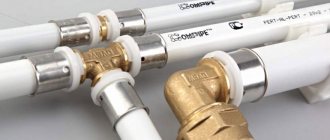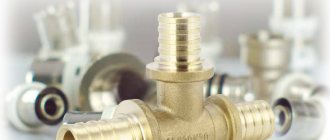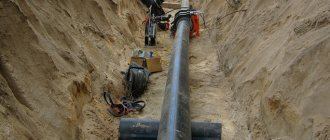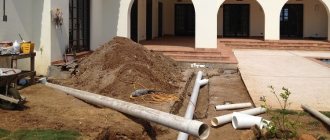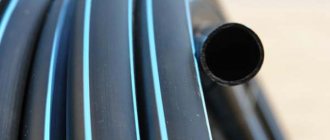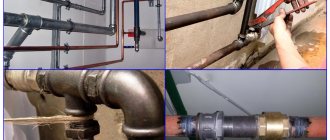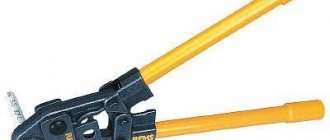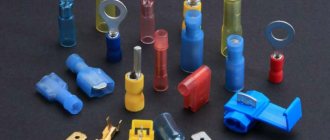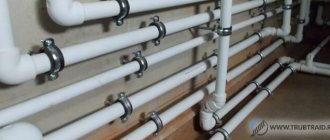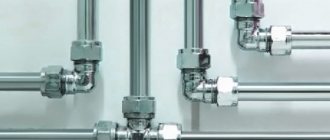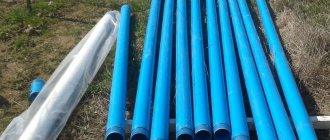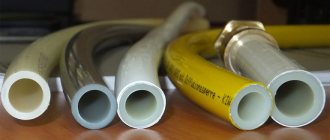Hello, dear readers! To assemble pipelines from modern materials, welded connections are almost never used, but fittings are used. They allow you to quickly assemble a reliable and sealed network from individual elements. And if you need to replace a damaged section or connect an additional line, you just need to unscrew one of the connectors. Today we will look at fittings for metal-plastic pipes, the rules for their selection and installation features.
Device and purpose
Fittings for metal-plastic pipes consist of a hollow body with two or several outlet holes (depending on the number of branches). Each outlet is equipped with a threaded fitting, which is inserted into the part to be connected. The threaded connection is supplemented with a union nut or ferrule.
To seal the joint, elastic gaskets made of vulcanized rubber are used. The body is usually made of brass, bronze or polymer materials - PPSU, PVDF. To protect against corrosion, metal products are nickel-plated or coated with a layer of tin (tinning).
Shaped connectors are used to assemble:
- Internal cold and hot water supply networks.
- Heating system wiring.
- Connections to mixers.
- Flush fittings for toilet cistern, etc.
Push fittings
The new push-on connections are very simple in design and their main advantage is that their assembly requires only a chamfering calibrator and pipe cutting shears. During installation, the calibrated edge of the pipe is inserted inside the ring clamp, the clamp is pushed slightly in the opposite direction and the ring, thanks to a special spring clamp, presses the pipe against the sealing rubber rings.
This assembly principle greatly facilitates and speeds up installation work. The manufacturer of the push fitting claims that the connection is quite easy to disassemble if necessary. The union nut is easily twisted, after which the pipe is removed. The most recent development of fittings for metal-plastic systems are push fittings made of polyvinylidene fluoride (PVDF) or fluoroplastic-2. Working on the same principle as brass construction, it is cheaper and does not corrode. So far, only a few parts are offered on the market, but it is likely that after some time their range will expand.
Advantages and disadvantages
The advantage of using fittings for assembling pipeline systems from metal-plastic pipes is:
- The simplest and fastest installation possible.
- Possibility of connecting metal-plastic pipes with parts made of other materials: copper, steel, stainless steel, plastic.
- Ability to ensure complete tightness of joints, minimizing the risk of leaks.
- An extensive range that allows you to assemble a pipeline of any configuration.
- Relatively low prices available to most consumers.
The disadvantages of such products include the need for maintenance. Therefore, assembled structures cannot be embedded in walls, floors or hidden behind permanent cladding; they must always remain open access.
Classification and types
The classification divides fittings into different types depending on their purpose and method of connection.
By purpose
Depending on the intended purpose, fittings are of the following types:
- Bends and corners. Installed in places where the pipeline changes direction at a certain angle (from 45º to 120º).
- Tees and crosses. Used to connect two or three branches at right angles to the main line.
- Muffs, American. Used for joining metal-plastic pipes of the same diameter.
- Adapters. They combine products of different sizes and materials.
- Plugs. Installed on dead-end lines of systems.
- Shut-off type fittings (taps, cocks, valves). They are used to temporarily or permanently stop flow in a certain direction.
By connection method
Depending on the connection method, fittings for metal plastic can be divided into three types:
- Compression (collet and crimp). They consist of a body, a ferrule, two synthetic rubber seals and a union nut. Form a detachable connection. Designed for use in pipelines with a diameter of 16, 20, 26, 32, 40 mm with a working pressure of no higher than 25 bar and a temperature range of up to 115 ºС. Installed using an adjustable or open-end wrench. If they fail, you don’t have to replace them completely, but replace only the worn-out element.
- Press fittings. They provide a permanent monolithic connection. They consist of a one-piece body, a sleeve made of stainless steel, a clip - an elastic ring connecting the sleeve to the body. Can be used for hidden installation of heating system wiring and underfloor heating pipelines under a screed. They are installed using a hydraulic press machine with microprocessor control or a manual analogue - press pliers by compressing the sleeve around a metal-plastic pipe.
- Push fittings. Can be used for any type of installation, incl. hidden. Refers to detachable type connectors. Install without tools. They consist of a housing, two sealing rings, internal crimp rings with locking springs, and an outer casing with inspection holes. When installing, the connector is simply pushed onto the prepared end of the pipe until it stops. To control the quality of joints, windows on the body are used.
Press fitting
These fittings are fundamentally different in their design from collet connections and push fittings. The design of this connection does not include a clamping ring or a clamping nut. Their role is played by a short tube made of thin stainless steel, and there is only one o-ring.
During installation, the metal-plastic pipe is cut in the required place, calibrated with chamfering and simply put on the fitting. It is very important to ensure that the pipe reaches the stop. For this purpose, there are slots and a control plastic ring, which will be visible in the slots when the pipe is in place.
After this, using manual, hydraulic or electric pliers, the stainless steel tube-clamp is crimped so that the two clamps of the clamp are at the edges of the rubber sealing ring.
The connection obtained in this way is very reliable and can be used even when poured into concrete, or inside a stone wall. The most serious disadvantage of this installation method is the need to use special, expensive tools.
Which ones are better suited for plastic pipes?
To join metal-plastic pipes that will be filled with concrete screed on top or hidden in walls, it is better to use press-on fittings. They form a more reliable connection that does not require maintenance, withstand high temperatures well and are 1.5 times cheaper than their crimp counterparts.
Compression connectors must be visible, as they require tightening the nuts at least once a year. It is better to install them on water pipes, since when used in systems with high temperatures, the sealing gaskets quickly fail. They can be repeatedly disassembled and reassembled to repair or replace sections of the pipeline.
Push fittings are very quickly installed, but there are still few of them on sale. This is a new type of shaped parts; they are produced by a few manufacturers.
Tips for choosing
When purchasing fittings for metal-plastic pipelines, pay attention to:
- Compliance of their technical characteristics with the parameters of the utility network.
- Labeling, availability of quality certificates from the manufacturer. The markings must be uniformly raised or deep, with clearly distinguishable letters.
- Guarantee period. For fittings for metal-plastic pipes from leading manufacturers, it is usually 10 years.
- Material of manufacture. The ferrules or shank must be made of stainless steel. They compress the metal-plastic pipe more evenly along the entire circumference than plastic rings.
- Product weight. If it is too light, then the body is made of silumin, not brass.
- Product reviews.
Fittings and tools must be of the same brand as the metal-plastic pipes so as not to violate the assembly technology.
Best manufacturers and approximate price
Many companies are engaged in the production and sale of shaped parts for metal-plastic pipes. The best of them are:
- Company from Belgium HENCO INDUSTRIES NV;
- Russian-Italian company VALTEC SrL,
- German company Rehau.
The cost of fittings for metal-plastic pipes varies, but you should not buy too cheap products. Most likely this is a low quality fake. Approximate prices are shown in the table.
| Name | Minimum price, rub. | Maximum price, rub. |
| Crimp connectors | ||
| Couplings, adapters | 95 | 850 |
| Corners, water sockets | 130 | 980 |
| Tees | 200 | 1650 |
| Crosspieces | 380 | 760 |
| Press fittings | ||
| Couplings, adapters | 110 | 820 |
| Corners, water sockets | 140 | 986 |
| Tees | 562 | 934 |
| Crosspieces | 386 | 820 |
| Push fittings | ||
| Couplings, adapters | 458 | 860 |
| Corners, water sockets | 560 | 1020 |
| Tees | 480 | 1230 |
| Crosspieces | 510 | 1800 |
How to choose fittings for metal-plastic pipes: a visual comparison of product quality
Compression fittings
The photographs show two fittings: high-quality (upper) and low-quality (lower). What is their difference? First of all, this is the presence of a skirt on the nut of the upper fitting. Even if both fittings are high quality, it is much easier to tighten the product tightly with a skirt.
The photo shows that in this case it was possible to completely tighten the nut only thanks to the presence of a skirt. From this we can conclude: in some cases, the absence of a skirt can complicate the work. And, of course, we cannot say that only the skirt makes the fitting quality. It is clearly visible that it is made of thin metal of an unknown alloy. Moreover, the nut has too sharp edges, indicating that they clearly wanted to save money during its production. The product in the first photo has gentle edges.
In the pictures there is a nut on the right of a high-quality fitting, and on the left, accordingly, a nut of a low-quality product. It can be seen that it cracked during installation (photo 1, 3). Pay attention to the inscriptions (photo 1). On the right nut the inscription is applied carefully and, apparently, during the casting process. The numbers on the left nut are pressed in so carefully that the edge of the product is slightly wrinkled. Look closely and you'll see that the nut has snapped in an "L" shape. Take a close look at the difference in the nuts. The right nut is thicker, so it will not break if installed and used correctly. Now let's look at the fittings themselves:
In the first photo, look closely at the thickness of the metal, and in the second, at the thread. In the third and fourth photos, look at the “cones” themselves. What exactly is there to see here? In picture 3, pay attention to the upper part where the metal-plastic pipe will be placed. It can be seen that on the left fitting the end is “cut off” almost immediately, and on the right, the inner part of the end expands gradually, more cone-like.
In photo 4 the same thing, only there is a narrowing inside. This is not so significant, but if such connections are used at a sufficiently high water pressure, then the absence of cones will lead to noise when water passes through.
If you need to make 5 similar connections, and you plan to purchase exactly 5 fittings, then you need to carefully inspect each of them. To do this, you need to unscrew the nut, examine whether both rubber gaskets are intact and whether there is a defect on the ring. There must be a cut on the ring; without this, the connection will not be sealed.
If you need a lot of these fittings, then buy two spare ones, since the rubber gaskets can be damaged during installation. To avoid this, chamfer the pipe.
Look at the photo to see what connection options are possible:
If you cannot choose a fitting for metal-plastic pipes with the required angle, bends, adapters, and nipples will help you.
It is acceptable to use an old, used fitting of a suitable type. It is important to choose a good quality fitting. Be sure to inspect it: there should be no cracks on the product. Replace both rubber gaskets.
Press fittings
Now we will help you choose press fittings for metal-plastic pipes. When installing them, you cannot do without a special press.
The press fitting looks like this:
The same fitting disassembled:
Press fittings for metal-plastic pipes come in the following types: tees, bends, water sockets, connectors, etc. All you have to do is choose what you need!
Read material on the topic: Spring for metal-plastic pipes
Installation and replacement rules
When connecting metal-plastic pipes, you do not need to cut a thread, but you still have to carefully prepare the end. Preparation of pipe elements for joining includes:
- Cutting the pipe at right angles.
- Straightening the product profile using a calibrator.
- Removing an even chamfer from the end of a pipe.
- Cleaning the end of the product from dust and remaining chips.
In the warm season, work can begin immediately, regardless of where the building materials were stored. In winter, they are first placed for several hours in a warm room, where they can dry out condensation and warm up to room temperature. Then it will be possible to begin installation work.
At the end of assembly, the metal-plastic pipeline is checked for leaks. If any connections are leaking, they must either be redone - in the case of using press fittings, or tightened if the assembly was carried out on crimp parts.
To repair split-type fittings, it is advisable to use a special replacement set of parts from the manufacturer.
Installation technology
The installation of a crimp fitting is carried out according to the following scheme:
- Preparation of the ends of the metal-plastic pipes to be connected according to the described sequence.
- Disassembling the fitting into elements.
- Place a union nut, a sealing gasket, a cut ring, a second sealing gasket on the pipe one by one, and then tightly insert the fitting into it.
- Tighten the nut until it stops, first by hand and then with an adjustable wrench.
Installation of a press fitting consists of the following steps:
- Prepare pipe parts in the same way.
- Lubricate the edge of the pipe with soapy water.
- Insert into a metal-plastic pipe fitting with a press sleeve.
- Squeezing the sleeve with pliers.
Practical Use of O-Rings
To avoid leaks of gases and liquids from pipelines, it is necessary to properly seal the connecting and shut-off valves with rubber or other seals. To seal HDPE fittings, rubber or polyurethane O-rings are used. Production and characteristics of rubber rings with a circular cross-section must comply with GOST 9833-73. Hydraulic and pneumatic devices are equipped with O-rings that comply with GOST 18829-73.
Valtec brand o-rings are popular. Round rubber bands (with a diameter of 16 mm or more) from this Russian-Italian company ensure the full functioning of heat and water supply systems for industrial and domestic purposes. Buying a 6mm O-ring for valtec metal-plastic fittings means acquiring quality, strength, and reliability of connections.
Rubber sealing gaskets have found their use in crimp and compression fittings, which are used to connect different elements into a single pipeline. Fittings connect metal-plastic, plastic, polypropylene pipes.
Using a special kit, you can solder the risers. But the soldering process takes a lot of time, and additional equipment is required. Therefore, they use compression fittings, with the help of which the pipeline system is strong and reliable. Although the cost of collet (crimp) fittings is slightly higher, they are convenient, durable, and reliable. High tightness is ensured by a rubber ring clamped with a nut.
Indispensable sealants for sewer pipes are sewer cuffs 110. It is these sealers that ensure “odor-free” transportation of wastewater.
